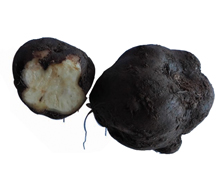
- Address : P.O. Box 11, Gannoruwa rd, Peradeniya, Sri Lanka
- E- Mail : director.hordi@doa.gov.lk
- Telephone :(+94) 081-2388011-12-13
- Fax :(+94) 081-2388234

Innala
Coleus rotundifollius /Solenastemon rotundifolius
Released Varieties
Climatic requirements/ Areas suitable for cultivation
Year around rainfall distribution is better. High day and night temperature gap is important for tuber formation
Most suitable growing areas – wet zone specially Galle, Kalutara, Colombo, Gampaha, Matale, Matara, Rathnapura districts
In addition Kurunegala from intermediate zone and Hambantota from dry zone (Minor)
Soil
Well drained light Sandy loam soil
Cutting requirement
Nursery size is depend on 12% – 15% from the cultivation extent
Land preparation
light soil is suitable for better tuber formation
Nursery Management
Sprouted healthy tubers were used as planting materials
To induce sprouting seed tubers were spreaded on the cement floor
Sprouted tubers were placed on nursery beds with50cmx 50cm spacing
Fertilizer recommendation for nursery ( before planting tubers 4m2 of beds)
Urea | 15g |
TSP | 25g |
MOP | 40g |
Cowdung | 10-12kg |
To increase shoot growth, liquid fertilizer or cattle urine can be applied as follows,
At 3-6 weeks (Some traditional farmers practice)
Cattle urine 1: water 1
OR
Liquid fertilizers (Albert solution, Green care, Crop master) 2-
At 2-3 weeks, (common used)
Urea – 10g For 1m2
MOP – 10g
Planting
Crop pattern is depend upon the season and climatic zone
Wet Zone – June -july with the onset of rain
Dry Zone – September – October with the onset of high rain
Third season cultivation – August soon after paddy harvesting
Spacing
At the nursery – 50cm*50 cm sprouted one tuber per hill
Yala season – cuttings (30cm*30 cm)
Maha season – cuttings (15cm*15 cm)
Fertilizer
Both organic and inorganic fertilizer can be applied to obtain high quality and economic yield
Cow dung is recommended as organic manure for high yield
Application time | Urea (Kg/ha) | TSP (Kg/ha) | MOP (Kg/ha) |
Before planting | – | 150 | – |
2 WAP | 65 | – | 60 |
6-8 WAP | 65 | – | 90 |
10-12 WAP | – | – | 60 |
*Fertilizer should be applied before flowering.
*If soil PH is less than 5, 1-2 kg/ha of dolomite can be applied to the soil two weeks before planting to adjust the optimum level.
*Final MOP dose is very important to obtain large and quality tubers.
Water supply
Depend on rainfall and area
Weed Control
Only for nursery and first month
Pest Management
Not reported earlier, during last 2-3 years Cutworm –attack (Spodoptera litura ) was reported
Nematode damage can be identified with repeat cultivation of the same crop during prolonged period,
Control
- Crop rotation
- Application of poultry manure to the soil
- Use healthy seed tubers
Disease Management
There are no significant diseases damage identified for the cultivation of innala. But can cause roundworm (nematodes) damage when planting innala in the same field for a long time.
Root nodules caused by roundworms can lead to stunted growth and death of the plant.
To avoid this
- Use of healthy seed tubers
- Organic chicken manure can be used.
Harvesting
From January to February, when vegetative part of the plant is turned yellowing
Use hand fork to expose tubers carefully from the soil to prevent tuber damages
Yield
Average yield 10-12 tons/ha
Potential yield 18-20 tons/ha (Low lands)
